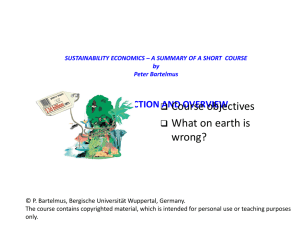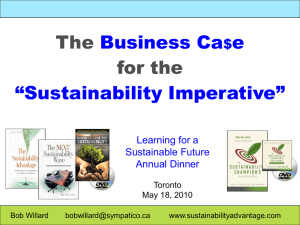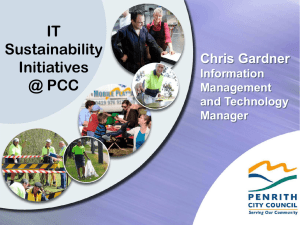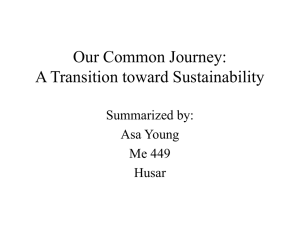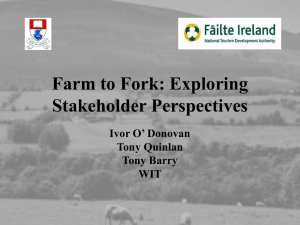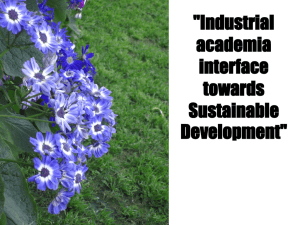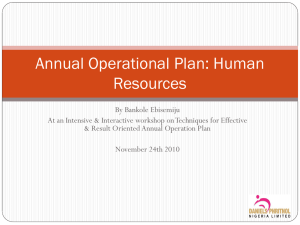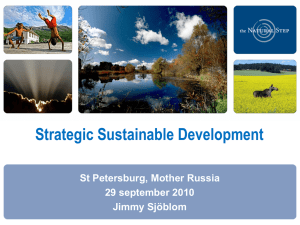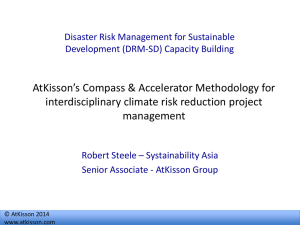Presentation 1 - CAUCE Conference
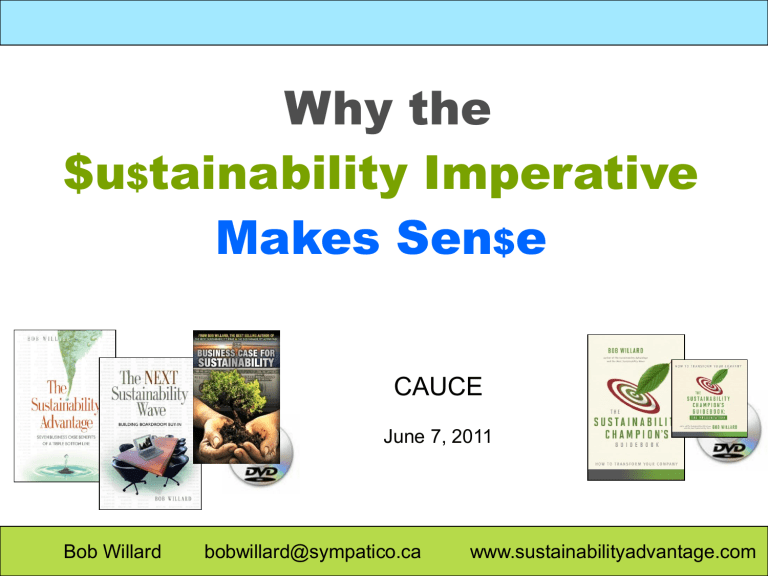
Why the
$u
$
tainability Imperative
Makes Sen
$
e
CAUCE
June 7, 2011
Bob Willard bobwillard@sympatico.ca www.sustainabilityadvantage.com
The “Sustainability Imperative”
Megatrend: “ A fundamental shift in the competitive landscape that creates inescapable threats and game-changing opportunities ... profoundly affects companies’ competitiveness and even their survival.”
Over the last 10 years, the “ Sustainability Imperative” has emerged, magnified by escalating public and governmental concern about climate change, industrial pollution, food safety , and natural resource depletion , among other issues.”
David A. Lubin and Daniel C. Esty, “The Sustainability Imperative,” HBR May 2010
Significant CEO Mindset Shift
CEOs Agree /Strongly Agree that sustainability should be ….
2010 Increase
Over 2007
… fully embedded into company strategy and operations
… discussed and acted on by boards
… fully embedded into subsidiaries’ strategies and operations
… embedded throughout the global supply chain
… the basis for industry collaborations and multi-stakeholder partnerships
… incorporated into discussions with financial analysts
Survey of 766 worldwide CEOs, including 50 in-depth interviews
UN Global Compact and Accenture study, “A New Era of Sustainability,” June 2010
Stakeholders Driving Sustainability
Stakeholders who CEOs believe will have the greatest impact on the way they manage societal expectations
Consumers
Employees
Governments
Communities
Regulators
Media
Investment Community
Suppliers
NGOs
Boards
Organized Labor
Other
Survey of 766 worldwide CEOs, including 50 in-depth interviews
UN Global Compact and Accenture study, “A New Era of Sustainability,” June 2010
CEOs: Sustainability Drivers
Top 3 drivers of CEOs’ action on sustainability issues
Brand, trust, and reputation
Potential for revenue / growth / cost reduction
Personal motivation
Consumer / customer demand
Employee engagement and recruitment
Impact of development gaps on business
Governmental / regulatory environment
Pressure from investors / shareholders
Survey of 766 worldwide CEOs, including 50 in-depth interviews
UN Global Compact and Accenture study, “A New Era of Sustainability,” June 2010
Sustainability 3-Legged Stool
Sustainability
Economic Leg
Good Jobs
Fair wages
Security
Infrastructure
Fair Trade
Environmental Leg
0 Pollution & Waste
Renewable Energy
Conservation
Restoration
Social Leg
Working conditions
Health services
Education services
Community & Culture
Social justice
Quality of Life / Genuine Wealth / Genuine Progress
Corporate Sustainability 3-Legged Stool
Sustainability = Sustainable Development (SD)
= Environmental, Social, Governance (ESG)
= Corporate Social Responsibility (CSR)
= Corporate Responsibility (CR) = Green
= Triple Bottom Line (TBL) = 3Es = 3Ps
E nvironment P lanet
Eco-efficiencies
Eco-effectiveness
E conomy P rofits
Growth, Jobs,
Taxes
Products
Services
E quity P eople
Employees
Community / Culture
World
Smart Business 3-Legged Stool
Economic / Financial
Capital
Built / Manufactured
Capital
Asset Management
Natural
Capital
Human Capital
Social Capital
Sustainable Value Creation
5-Stage Sustainability Journey
5.
Purpose/Passion
Values-driven founder / CEO
4.
Integrated Strategy
Enhanced organizational value
3.
Beyond Compliance
Save on eco-efficiencies
Avoid PR crisis
Avoid threat of new regulations
2.
Compliance
Regulatory enforcement
1.
Pre-Compliance
The 3 R’s of Justifying Sustainability
R ISKS
+
R ESPONSIBILITIES
+
R EWARDS
BUSINESS CASE
Based on Alan AtKisson, The IRIS Agreement , p. 127
Risks to Financial and Natural Capitals:
Big-5 Sustainability Storm Fronts
Waste, Toxicity, and Health
Species Extinction and
Overharvesting
Poverty and
Social Injustice
Food and Water
Crises
The 3 R’s of Justifying Sustainability
R ISKS
+
R ESPONSIBILITIES
+
R EWARDS
BUSINESS CASE
Based on Alan AtKisson, The IRIS Agreement , p. 127
Risks to Financial and Social Capitals:
Stakeholders’ Rising Expectations
Waste, Toxicity, and Health
Poverty and
Social Injustice
Species Extinction and
Overharvesting
Food and
Water Crises
(NGOs) Media
Economists
The Public
Investors
Customers
Employees
Risks to Reputation re
Corporate Responsibilities
Banks
Governments Insurers
Competitors
Markets
(Scientists)
The 3 R’s of Justifying Sustainability
R ISKS
+
R ESPONSIBILITIES
+
R EWARDS
BUSINESS CASE
Based on Alan AtKisson, The IRIS Agreement , p. 127
Top 10 Business Priorities for 2011
Forrester's survey of 2,691 executives in Europe, North America, and Asia,
“Forrsights Business Decision-Makers Survey, Q4 2010.”
One More Goal … or an Enabling Strategy?
Profit
Share price
Growth
Revenue
Market share
New markets
Customer care
Expenses
“Sustainability”
Talent wars
Productivity
Innovation
Brand image
Quality
Risks
Compliance
Governance
Supply security
Enabling Strategies
The 3 R’s of Justifying Sustainability
SME
Companies:
At least 66% more profit
R ISKS
+
R ESPONSIBILITIES
+
R EWARDS
BUSINESS CASE
Large
Companies:
At least 38% more profit
Potential SME Profit Increase
• Reduced recruiting costs
• Reduced attrition costs
• Increased employee productivity
-1%
-2%
+6%
• Eco-efficiencies: savings in energy/carbon, water, materials, waste handling
-10%
• Increased revenue / market share
• Lower insurance & borrowing costs
… yielding a profit increase of +66%
+5%
-5%
REPUTATION
Sustainable Procurement: U.S. Gov’t
Executive Order 13514
(Oct. 2009)
Federal Leadership in Environmental, Energy, and Economic Performance
Largest consumer of energy in the U.S. economy
Impacts 500,000 buildings and 600,000 vehicles
Impacts $500B / Yr spent on 2M goods and services
Impacts 600,000 suppliers
Green procurement policy covers 95% of new acquisitions
• Federal agencies must set 2020 GHG reduction goals
• 30% reduction in fleet gasoline by 2020
• 26% boost in water efficiency by 2020
• 50% waste recycling and diversion rate by 2015
• Net-zero-energy building requirement by 2030
Ecovadis survey, “Sustainable Procurement: A Crucial Lever to End the Crisis?,” Aug 09
The 3 R’s of Justifying Sustainability
R ISKS
+
(NGOs)
Climate Change
&
Energy Crises
(Scientists)
R ESPONSIBILITIES
Customers
Governments
+ Employees
Economists
Investors
Insurers
R EWARDS At least 38% to 66% more Profit
BUSINESS CASE
The New Economy
• Low-carbon economy vs. fossil fuel-based economy
• Local supply chains vs. global supply chains
• Services vs. products
• “Dematerialization” vs. physical goods, processes, or travel using “virtual” alternatives like videoconferencing or online shopping”
• Responsible consumption / thrift vs. over-consumption
• Low / No-growth model vs. “grow or die” model
• New ownership models: employees, customers, co-ops, social venture funds, government funding
• New company purposes: “Social enterprises,” “B Corps,”
“Hybrid organizations,” “Flexible purpose corporations”
(California Bill SB 201, Corporate Flexibility Act, Feb. 2011)
In Summary …
Sustainability is smart business
Green Universities are smart universities
New market forces & risks are in play
Relevant to existing priorities
Opportunity for leadership
1. Progressive policies and courses
2. Walk-the-talk in university operations
3. Use procurement clout
Why the
$u
$
tainability Imperative
Makes Sen
$
e
CAUCE
June 7, 2011
Bob Willard bobwillard@sympatico.ca www.sustainabilityadvantage.com


